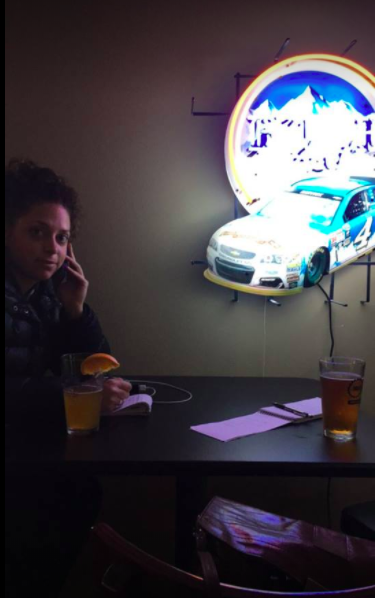2017 was quite a year, and full of a lot of firsts for me - my first time being published in a book, my first time visiting Iowa, and, now, my first time making use of the blog section of my website.
Below are my biggest journalistic milestones of 2017, and some excellent work from an array of talented media folks I’m proud to call my community.
Some of my favorite projects:
I investigated killer cops that work in Chicago public schools for the Chicago Reader (and the origins of the school to prison pipeline), reported on the first restorative justice court that opened this summer for The Atlantic, and (with Patrick Sier) sifted through weeks of contradictory statements and documents to understand the Chicago Police Department’s strategic subject list. Chicago had a budget crisis for much of 2017 - I did a series of stories including an explainer, an analysis of other state’s budget decisions and why workers compensation played such a big role in the budget debate. I was also able to do some fangirling during an interview with Masha Gessen for In These Times.
Overheard at cafe: "I hear there are two reporters in town from Chicago. They're doing a story on wind energy." 👀 (On assignment in Newton, IA)
Staked out a train, interviewed fifteen people, bought a wheelbarrow, lost and found a notebook. Pictured here: Michelle Kanaar running out of steam in Newton, IA.
Michelle Kannar and I had a banner year in 2017. My story and her photos on school closings in Puerto Rico was published in the Christian Science Monitor. We also both received a Social Justice News Nexus fellowship (along with a Fund for Environmental Journalism grant) to write about labor and green energy. We spent nearly a week in Newton, Iowa, where we became regulars at the local diner and unexpectedly came across a field of Midwestern llamas. You can see our work at In These Times and Midwestern Energy News. We were also lucky to have the chance to work with Kari Lydersen on a story about how solar energy is fighting Islamophobia in Milwaukee.
In 2016, Sarah Macaraeg and I wrote an article exploring how Chicago became the first city to make reparations to victims of police violence. The story won an ivoh Restorative Narrative award this summer, and will be featured in Belt magazine’s Chicago anthology. Here’s a pic of me nervously reading an excerpt at the Belt book launch:
Two short films I produced with Scrappers Film Group played on the big screen: Polvision at this summer’s CIMMFest and the Popcorn Politics episode about Wayne’s World at the ArcLight for the movie’s 25th anniversary. You can watch it’s exploration of how public access democratized television - and how YouTube distributed it - here.
SFG and I also took big steps on two feature documentaries: we screened a rough cut of Closing de Facto: Chicago State University in Crisis in partnership with City Bureau to a crowd of CSU alumni at the Chicago Cultural Center, and held a fundraiser for Stateville Calling, our documentary about one elderly activists’ effort to release elderly prisoners facing life without parole.
I’m also excited to announce that I’m joining a new project that I’ve loved ever since I first came across it. Starting in October, I became the new staff writer for Migratory Notes, a weekly newsletter synthesizing the most important immigration reporting each week created by Daniela Gerson and Elizabeth Aguilera. Check it out here.
Kickass 2017 work by writers, journalists and filmmakers I know and love in Chicago and elsewhere:
Carmen Aiken wrote a heartbreaking piece about the death of her grandfather. My housemate and pal Rebecca Burns has been digging deep into housing issues, first investigating the resurgence of contract selling and then on East Chicago’s lead legacy. Kalyn Belsha wrote about the thousands of black students who leave Chicago for other segregated districts (with pics by Michelle Kanaar). Martha Bayne wrote, and Michelle Kanaar photographed, a narrative about the thousands of Puerto Ricans coming to Chicago after Hurricane Maria. Stephanie Farmer released a policy report on the connections between the CPS financial crisis and charter schools. Angela Caputo investigated the inequality of Lake Michigan water rates. Scrappers Film Group launched a shiny new website. Danika Parikh and her team published an article exploring how ancient cultures dealt with unstable environments. Maria Ines Zamudio investigated aging immigrant workers retirement funding. Julia Zvobgo co-founded (and recently relaunched) Of Africa Mag, a community that celebrates women of African descent. Robin Amer, who skillfully edited by two big Chicago Reader investigations, is launching her own investigative podcast in 2018 with the USA Today network. Leor Galil covered some of the biggest and some of the quirkiest stories in Chicago music. Reshmi Rustebakke and Ricardo Gamboa published Brujos, a magical web series about 4 gay PhD witches using their powers to stop white supremacy. Sarah Macaraeg explored an $150 million deal to detain immigrants in New Mexico, and Sarah Lazare (with Debbie Southorn) looked into the Chicago police practice of sending SWAT teams to treat mental health emergencies. Jonah Newman and Geoff Hing made a handy tool to monitor Chicago's police reforms. Melissa Sanchez investigated the minimum wage hikes that some workers in Chicago just aren't seeing. Nikki Faust freaked me out with her Halloween extravaganza, Stay on the Line. And Miles Kampf-Lassin covered Chicago politics from the left.
City Bureau highlighted eight stories it published in 2017 - including two of mine - and a bunch of fellows published great work, including Jeremy Borden and his team on the toxic dust from demolitions, and Sarah Conway, Jenny Simeone-Casas and their team published several stories about what makes Chicago’s restorative justice court special, the grandmothers of RJ in Chicago and how peace circles work. And to keep supporting independent journalism in Chicago, you should join City Bureau’s Press Club.
That’s all for 2017.
Good night and good luck,
Yana

